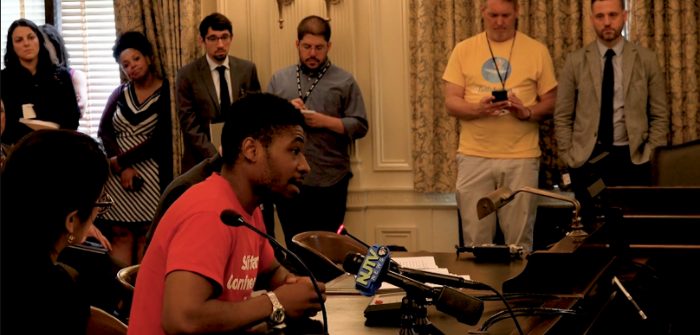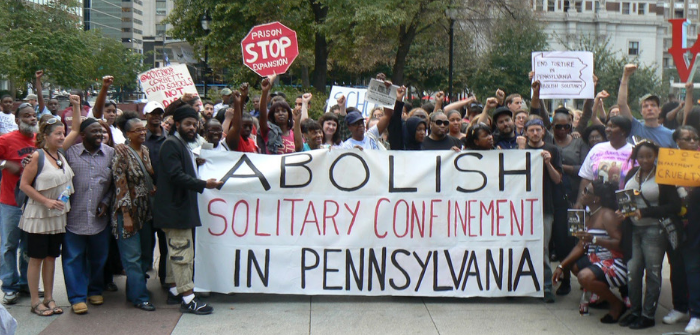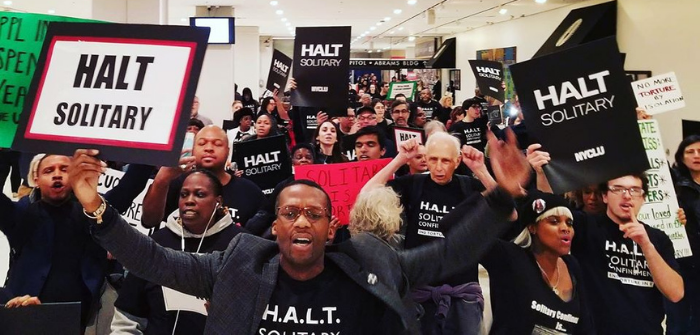FAQs - Prolonged Solitary Confinement in U.S. Prisons
- What is solitary confinement?
- Why do people of faith care about the use of solitary confinement?
- What is the history of solitary confinement in the United States?
- How does the United States use of solitary confinement compare to other nations?
- How much does housing prisoners in solitary confinement cost compared to housing prisoners in the general prison population?
- How long are individuals held in solitary?
- What does 'prolonged' solitary confinement mean?
- Who is held in solitary confinement and why are they placed in isolation?
- Is it possible to limit the use of solitary confinement and still keep prisons safe?
- How does the use of solitary confinement impact reentry of prisoners into society?
- What laws exist regarding solitary?
- How can I get involved with NRCAT's work on solitary confinement?
What is solitary confinement?
Solitary confinement is detaining an individual in a closed cell by isolating them for 22-24 hours a day. The individual is isolated from human contact and can be held for periods of time ranging from days to years and nearly every state uses the practice of solitary confinement.
Why should people of faith care about the use of prolonged solitary confinement?
The diverse religious traditions that comprise the National Religious Campaign Against Torture share a recognition of the inherent dignity of each human being and humanity’s capacity for redemption and restoration. The torture of solitary confinement desecrates a person’s inherent dignity, denies the essential human need for community, and is antithetical to rehabilitation.
What is the history of solitary confinement in the United States?
Dr. Benjamin Rush, Benjamin Franklin and several Quaker leaders first instituted solitary confinement at Walnut Street Jail in Philadelphia in the late 18th century, believing that total isolation and silence would lead to penitence (hence, the term ‘penitentiary’ was coined). That led to the building of the Southeastern Pennsylvania Penitentiary in 1829, which only had solitary confinement cells. However, instead of becoming penitent, the prisoners developed serious mental health problems. The Quakers recognized that solitary confinement caused severe psychological harm and apologized for their use of solitary confinement. Unfortunately, the U.S. has let history repeat. In the 20th century, some U.S. prisons had a limited number of solitary confinement control units within their facilities; however, in 1983, Marion prison in Illinois instituted a permanent ‘lock down’ of their entire facility, in which inmates were confined alone in their cells for 23 hours per day. The use of solitary confinement has increased dramatically since then. In 1989, California built Pelican Bay State Prison to house prisoners exclusively in isolation (the first “supermax” prison).
How does the United States use of solitary confinement compare to other nations?
The United States has become a world leader in holding prisoners in prolonged solitary confinement. The United States reportedly has five percent of the world’s population, 25 percent of its prisoners, and the vast majority of prisoners in long-term solitary confinement. Experts estimate that at least 80,000 people in the U.S. criminal justice system, including youth and individuals with severe mental illness, are held in solitary confinement. The 2006 Commission on Safety and Abuse in America’s Prisons (the Commission), issued a report, Confronting Confinement, stating that from 1995 to 2000, the growth rate of segregation units significantly surpassed the prison growth rate overall: 40 percent compared to 28 percent.
How much does housing prisoners in solitary confinement cost compared to housing prisoners in the general prison population?
Experts have found housing a prisoner in solitary confinement can cost as much as $50,000 more annually compared to general prison population housing, largely because solitary confinement units require significantly more staffing. The Commission reported that housing prisoners in solitary confinement units can double the cost of housing prisoners.
How long are individuals held in solitary?
15 days – one month 18%
1 to 3 months 29%
3 to 6 months 16%
6 months to a year 13%
1 to 3 years 13%
3 to 6 years 5%
6 or more years 5%
*The numbers reflects data for 54,364 solitary prisoners from 41 jurisdictions. Source: ASCA/Yale Law School
What does ‘prolonged’ solitary confinement mean?
It depends who says it. For the National Religious Campaign Against Torture (NRCAT), the term ‘prolonged solitary confinement’ is equated to torture — the point when the use of solitary confinement results in severe mental or physical pain or suffering. The United Nations Special Rapporteur on Torture, Juan Mendez, has stated that more than 15 days constitutes torture, and has called for a ban on the use of solitary confinement for youth and those with mental illness.
Article I of the UN Convention Against Torture and Other Cruel, Inhuman or Degrading Treatment or Punishment which has the weight of U.S. law, defines torture in the following way:
“For the purposes of this Convention, the term ‘torture’ means any act by which severe pain or suffering, whether physical or mental, is intentionally inflicted on a person for such purposes as obtaining from him or a third person information or a confession, punishing him for an act he or a third person has committed or is suspected of having committed, or intimidating or coercing him or a third person, or for any reason based on discrimination of any kind, when such pain or suffering is inflicted by or at the instigation of or with the consent or acquiescence of a public official or other person acting in an official capacity.”
Who is held in solitary confinement and why are they placed in isolation?
The criminalization of communities of color has resulted in people of color being disproportionately impacted by mass incarceration and solitary confinement. A majority of incarcerated people placed in solitary confinement are there mostly of non-violent rule infractions. In some prisons, solitary confinement has become a default tool; many incarcerated people with severe mental illness end up in solitary confinement because of difficulty understanding or following such rules, especially when their illnesses go untreated.
Is it possible to limit the use of solitary confinement and still keep prisons safe?
Yes, a growing number of states that have safely reduced their use of solitary confinement. For example, in Mississippi, the number of incidents involving prisoner-on-prisoner violence and prisoner-on-staff altercations fell drastically when corrections officials implemented significant reforms in 2007, limiting the use of solitary confinement. “The [segregated housing] environment . . . actually increases the levels of hostility and anger among inmates and staff alike,” Donald Cabana, former Mississippi Warden, told the Commission in 2006. In Mississippi they have allowed most inmates out of their cells for hours each day. They built a basketball court and a group dining area. They put rehabilitation programs in place and let prisoners work their way to greater privileges. This has been a model that other states have been monitoring.
How does the use of solitary confinement impact reentry of prisoners into society?
People who have been held in solitary confinement are significantly more likely to return to prison after they complete their sentences than those who have been held in the general prison population. For example, a Washington state study of over 8,000 former prisoners found that people who were released directly from isolation had a much higher rate of recidivism than individuals who spent some time in the general prison population before returning to the community: 64 percent compared with 41 percent.
What laws exist regarding solitary?
In the past decade, a movement has grown nationally and locally to abolish long-term solitary confinement. In 2017, Colorado became the first state to announce that it had virtually eliminated long-term solitary confinement and implemented the standards laid out by the Mandela Rules. Colorado has replaced prolonged solitary with alternatives that include step-down programs and mental health units. North Dakota also instituted more humane alternatives to solitary after its director of corrections visited prisons in Norway. Washington State has used innovative programs to greatly reduce its use of solitary confinement. Under pressure from lawsuits, California and New York have also significantly reduced their populations in solitary, and several additional states have worked with the Vera Institute of Justice’s Safe Alternatives to Segregation project to reduce their use of solitary.
How can I get involved with NRCAT’s work on solitary confinement?
As an individual or an orgainzation you can become a member of NRCAT, which gives you access to our action alerts and campaign opportunities. You can also sign the Statement of Conscience to condem the use of torture.








